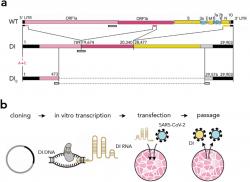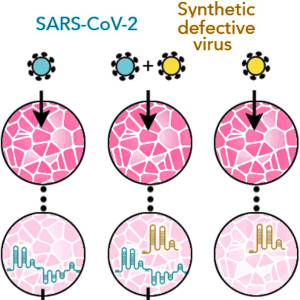Many different viruses, including coronaviruses, spontaneously form defective interfering particles, or DIPs. These are radically mutated genomes that are gutted so that they contain virtually no functional protein. They are like undead ghosts that parasitize on their complete cousins and replicate at their expense. Will we be able to make them allies?
–
Viruses live with zombie viruses in a difficult partnership. Credit: Yao et al. 2021
–
People tend to see nature and the processes that take place in it as a showcase of perfectionism. Perfect fit, perfect balance and so on. In fact, of course, it is exactly the opposite. Nature is full of unfinished business, mistakes and mistakes that pile on top of each other. Viruses are no exception, as they can be tough opponents, but they also have their problems.

Marco Archetti. Kredit: Pennsylvania State University.
–
We have known since the 1950s that virtually all groups of DNA and RNA viruses spontaneously form, often in large numbers, defective mutants, picturesquely nicknamed DIPs, according to the English Defective Interfering Particle (or DVG, or Defective Viral Genomes, or DI RNA). or DI DNA). These are not mutations of the kind that are now leading to the emergence of new dreaded variants of pandemic coronavirus and pumping adrenaline into (hopefully) the final phase of a pandemic. DIPs often have a brutally gutted genome in which large or huge pieces of sequences, often entire genes, are missing. As a result, DIPs are not considered infectious, although they may enter the host cell. They do not function on their own in the cell and need more, fully functional virus particles to get there. They are such undead viruses, viral zombies.
The formation of DIPs is natural, it occurs spontaneously. It can also be induced in the laboratory, and it is also possible to generate synthetic DIPs. Unfortunately, as is still the rule in virus biology, we still do not understand much about the functioning of DIPs and their effect on fully functional viruses and the entire infection. It has gradually been shown that DIPs can stimulate the immunity and antiviral defenses of the host, can contribute to the formation of long-term viral infections, and can also disrupt the replication of standard viruses.

Complete virus (WT) and defective genomes (DI0 and DI1). Credit: Yao et al. 2021
–
Defective viruses cannot replicate themselves. They must parasitize on viruses with a complete genome. If DIP and a functional virus co-infect, DIP can “steal” the necessary components of the replication apparatus. When this happens, DIP is suddenly at an advantage. It replicates much faster than a complete virus because it is shorter due to the gutted genome. This weakens the infection. And we could use that to fight dangerous viral infections like covid-19.
Marco Archetti of Pennsylvania State University and colleagues produced synthetic DIPs of the SARS-CoV-2 pandemic coronavirus. These genomes do not contain any functional protein, but are also capable of replication and packaging into a viral particle. If Archetti’s team’s DIPs enter cells along with complete pandemic viruses, they begin to parasitize on them and replicate at their expense. As a result, the viral load in such cells is halved within 24 hours.
Researchers believe that similar synthetic defective genomes could function as an effective antiviral treatment. In this case, covid-19. Similar synthetic “zombie” viruses should work in the case of many other viruses. However, the development of this treatment will continue. It will be necessary to perform in vivo experiments, to tune the route of application of synthetic DIPs, and also to monitor the coevolution between DIPs and the corresponding complete viruses. At the moment, it’s a long-distance run.
Literature
Nature Microbiology 4: 1075–1087.
Pennsylvania State University.
– .


